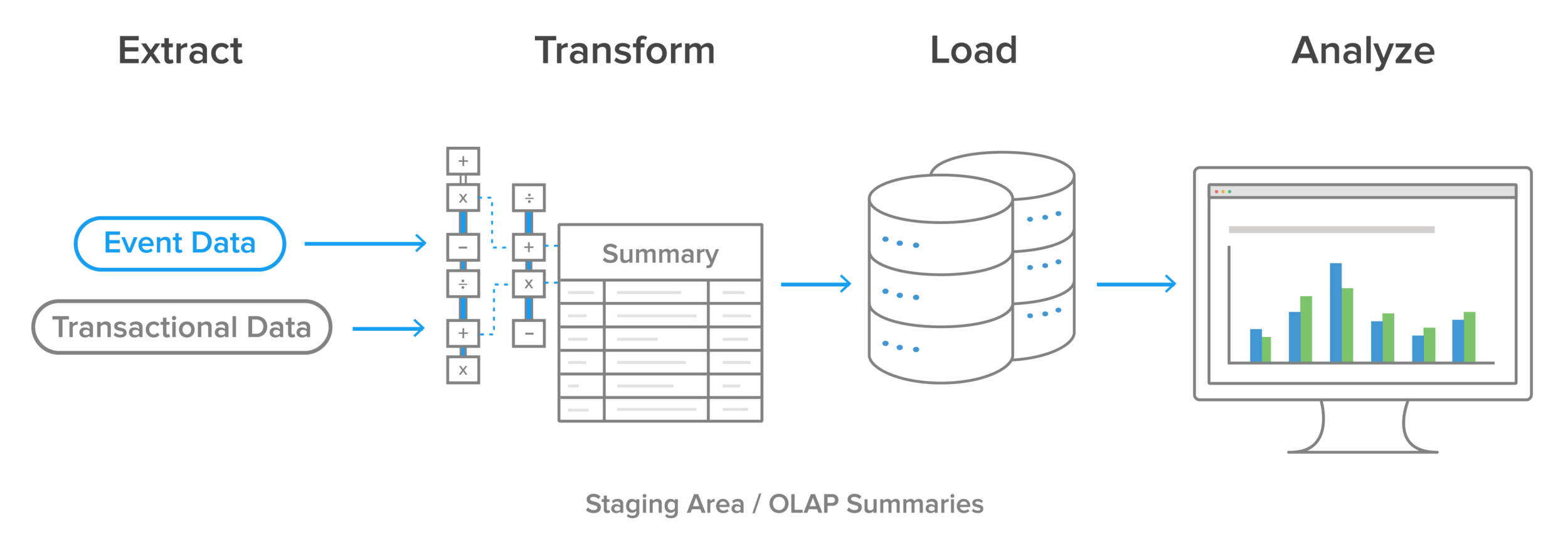Confused between ETL and data preparation? Not sure which method to follow? Here’s everything you need to know about ETL vs data preparation.
This article covers:
- A brief overview of ETL
- Why ETL is no longer effective
- An overview of data preparation
- Key differences between ETL and data preparation
- Which method suits your business best
- Preparing data with Data Ladder
A Brief Overview of ETL
Extract, Load, Transform (ETL) hardly needs an introduction. Developed in the 1970s, this workhorse technology was used to blend data from multiple sources. The primary actions being:
Extracting: Deriving, copying or pulling out data from a system source
Transforming: Reformatting the data to be used in a new system
Loading: Inputting data into the new system

ETL solutions helped companies consolidate data from multiple sources especially during the 1980s and 90s when data warehousing became popular, ETL was used to integrate data from multiple systems – mainframes, PCs, spreadsheets, etc into one database. The problem? As data complexity increased, companies began using different ETL tools to manage different types of data warehouses.
Over time, as data formats, systems and sources expanded – in complexity and in volume, traditional ETL methods were no longer able to hold up. Although the basic ETL process remains a core component of the data ecosystem, its challenges have given rise to newer approaches and processes.
Challenges with ETL:
A typical ETL system is effective when data is structured, batch-oriented and has been regularly updated. However, with time-sensitive streaming data, ETL systems tend to falter unless the system is tweaked through custom programming. Even then, an ETL system in a real-time environment will be challenged with the requirements of low latency and high availability.
The ETL process itself became increasingly complex especially since data formats expanded and multiple scripts, APIs were required against each format to parse data. This implied that if compatible APIs or drivers were not available, ETL specialists had to specifically code an ETL process – a tedious task considering a data source from an average company would have millions of rows of data.
Although there are many commercially available ETL tools in the marketplace, capable of handling complex data and overcoming ETL challenges, they still need a significant learning curve and additional process implementation to make data usable.
Enters data preparation solutions.
What is Data Preparation & How is It Different from ETL?
ETL and data preparation is often confused as one process. While there is some truth to this, since data preparation does involve the process of extracting and transforming data and solving the same problems, there are distinct features that make data preparation a more flexible method than ETL.
Data preparation can be described as the process of “preparing” or getting data ready for analysis and reporting. Although it is similar to ETL, it is a visual, self-service, easy-to-use solution that gives a business user the ability to prepare data as compared to ETL which was primarily an IT process handled exclusively by the IT team.
According to Jon Pikington from Dataversity, data preparation is, “the technology that allows administrators to make faster and better decisions through data quality and data access.”
Businesses use data preparation to:
- Make it easy for business users to prepare their data according to analysis requirements
- Reduce the burden on IT and make data preparation an automated process
- Make sense of complex data
- Match, consolidate, clean and fix problems with data without demanding technical or programming expertise.
So, while ETL is a technical process implemented to move data, it lacks the additional features that data preparation solutions tend to offer. Some of the key benefits of using data preparation include:
- Data is Prepared by Those who Know it Best
The key benefit of data preparation is the fact that data can be prepared by business users who know it best. For example, business users in the marketing department can use a data preparation tool to identify their most active social media users which if left with IT wouldn’t yield an accurate result. Data is more than just numbers and text – there is an inherent context in every data set that can only be understood and identified by the people who will be using that data.
- Making Predictive Analysis Easier
Predictive analysis refers to the process of predicting entity (customer) behavior and expectations through the study or analysis of current data sets. Companies need to match multiple data sources such as social media sources, online surveys, buying behaviors, purchase history, ticket history, etc to obtain a picture of their audience, thus allowing them to make predictions.
ETL does not allow for this level of intelligent data matching and consolidation, therefore, rendering it useless for any business that wants to derive strategic insights. Data preparation tools, on the other hand, allow for businesses to match complex data fields within or across multiple data sets and creating a consolidated, single source of truth without the need for any technical skills or knowledge.
- Flexibility in Data Cleaning
ETL tools rely on rules and structured workflows. Issues such as abbreviated names, extra characters, misspellings or even punctuations in phone numbers need to be pre-defined for the ETL to catch them. Most of the time though, some errors are so deceptive in nature (for example the use of nicknames vs real names) that it’s hard to pre-define them and create rules for them. Secondly, ETL implies that a user must know the flaws in their data before they can be fixed – but there are many instances where a user simply does not know of the issues plaguing their data.
Data preparation tools do not impose such rules on users. In fact, the market’s best-in-the-class data preparation tools have pre-defined algorithms that capture every possible issue with a data field and lets the user see the problems with their data. The tool gives the user a visual representation of the health of their data – columns with missing or invalid data, fields with spelling or character mistakes, extra spaces between characters etc can all be seen and fixed by the user before making use of the data.
As you can now see, ETL and data preparation though essentially performing the same functions has distinct uses. Where ETL is a back end, data extraction process, a data preparation tool is a business tool allow users to further refine and prepare their data for business use.
Using a Data Preparation Tool’s API With an ETL Pipe – An Example
Many businesses use both ETL and data preparation to effectively manage their data. This is made possible by integrating the data preparation tool’s API to the ETL pipe of the organization’s data ecosystem. This way real-time data is cleansed and matched before the ETL tool loads that data into a new data source.
Here’s a small example of one of Data Ladder’s clients using both ETL and our data preparation software to achieve their goals.
Think of an ETL scenario where the organization has a ton of core/master data, and they’re processing thousands, tens of thousands, hundreds of thousands, or millions of transactions daily/weekly, etc. and want to stream this data against their core data, enriching their core data with the transaction details.
The use case for streaming is predictive analytics. The organization has core data, and they are also pulling in large amounts of additional data, to enrich their core data, things like consumer interests, credit score, Geolocation info. etc, ETL solutions don’t do the matching very well. So, they want to enrich this core data with tons of new data, in real-time, on the fly, and it won’t work if the name from their core database is Peggy Sheridan and the name from this new data is Margaret Sheridan.
The organization’s ETL pipe can use Data Ladder’s API to invoke the cleansing and matching to pull in the unique id from their core data, appending that unique id onto the matching new data, to update their core data with these new attributes.
How Does Data Ladder Help with Data Preparation?
Data Ladder’s flagship software, DataMatch Enterprise allows for easy data preparation by allowing users to:
Integrate Data: Integrate data from over 150+ applications and derive data sets that you need for your analysis and reports.
Profile Data: Identify the flaws with your data visually. You can see the issues affecting your data including spelling errors, number errors, punctuation issues and much more.
Clean Data: Data cleaning is achieved by simply applying pre-defined rules on your data. Duplicates are removed, invalid email addresses are highlighted and fixed, physical addresses are verified and validated along with many other functions. The objective is to help you get data you can trust.
Match Data: Match data from within, between or across multiple data sources using a combination of fuzzy matching algorithms and the software’s proprietary algorithm.
Merge: Merge corrected and matched data into a single master file and make it your single source of truth before loading this new information into a new system or source.

What is Best For Your Business?
The choice is quite simple. If you have a forward-thinking IT team that can overcome the complexities of modern data and can constantly update data through regular tweaking and monitoring of the ETL process, then you can rely on ETL to sort your data. There are many situations where an ETL solution is still preferred, especially for cases where billions of rows of data are transformed and bulk-loaded into data warehouses and that the nature of the data does not significantly change over time. Note though that ETL is a time-consuming process. Even if you use commercial software, you will still have to significantly program it to meet your requirements.
Data preparation tools like that of DataMatch Enterprise allow for much more flexibility allowing for businesses to get timely findings and use data for in-depth analytics and reporting from business managers themselves. No additional tweaking, programming knowledge or extra skills is required to make sense of data.
Conclusion
The data ecosystem is complex and requires a combination of several tools and processes to deliver results. It’s prudent to understand which software or tool is best suitable for your business requirements. While you think an ETL tool is what you need, it may just be data preparation. The choice depends on your business objectives, resources and the kind of information you want from your data.
To know how our data preparation tool can help you generate accurate analytics and reports, get in touch with our solution architect today.









































